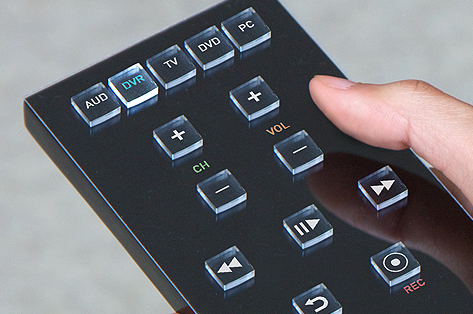CES 2013: Tactus Rises Above Fourth Wall of Touch Displays
January 11, 2013
The touchscreen changed the way users could interface with their devices and opened up a new realm of opportunities for software developers. Smartphone manufacturers, and more recently, tablet makers, have been exploiting this technology almost to a fault, lopping off nearly all the physical buttons from their designs, and with it, the physical connection between user and device. Tactus Technology aims to provide both with on-demand, transparent, physical buttons via their dynamic tactile interface.
 The tactile layer replaces the traditional top layer of the display but adds no additional thickness when inactive, and it doesn’t interfere with the underlying display or touch sensor. The system works by dispersing a transparent fluid that inflates an area of the polymer layer deposited on the surface of the display. The amount of fluid released and the location is all application-controlled allowing for transparent, physical buttons that can rise from the screen’s surface, vary in shape and change position.
The tactile layer replaces the traditional top layer of the display but adds no additional thickness when inactive, and it doesn’t interfere with the underlying display or touch sensor. The system works by dispersing a transparent fluid that inflates an area of the polymer layer deposited on the surface of the display. The amount of fluid released and the location is all application-controlled allowing for transparent, physical buttons that can rise from the screen’s surface, vary in shape and change position.
The company has already built prototypes for displays ranging from 3- to 15-inches, but the technology can be applied to any size screen. It could be used to replace haptic-based touch feedback and remedy several problem areas in the vehicle display and mobile gaming arenas.
Most notably, the tactile layer enables, or should we say re-enables, blind navigation of devices through touch, allowing users to keep their eyes on their current activity, whether it’s the road or Mario.
 The prototype available for demonstration at CES is designed to raise an entire keyboard’s worth of buttons, and even with a good understanding of the underlying technology, it doesn’t fail to astonish. One click and the keyboard sprouts out of the screen in less than a second.
The prototype available for demonstration at CES is designed to raise an entire keyboard’s worth of buttons, and even with a good understanding of the underlying technology, it doesn’t fail to astonish. One click and the keyboard sprouts out of the screen in less than a second.
The biggest question, however, is one of robustness. The company responds to these worries by explaining that it is using known materials, but it felt a bit delicate during my testing. Tactus also said its tactile layer wouldn’t affect touch sensor sensitivity, but the device’s response had some lag in response to button pressing. That being said, this could be a paradigm-shifting technology with applications for security, media playback and gaming across platforms ranging from phones to TVs.
While the pricing hasn’t been released yet, the company is working with OEMs to bring tactile interface-enabled devices to market this year.
The idea of physical buttons dynamically rising up from your touchscreen is something a still photo does not adequately capture. See the concept in action in this Tactus promotional video. CNN also posted an interesting 2-minute video report this week.

No Comments Yet
You can be the first to comment!
Leave a comment
You must be logged in to post a comment.